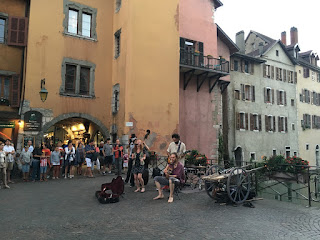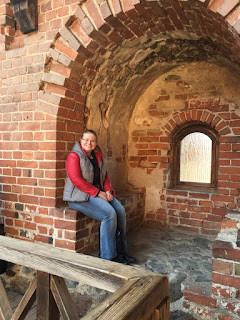My last destination was decided on by Lufthansa Surprise - just decide if you want Nature, Beach, Sightseeing, Shopping, Party or Metropoles, enter the dates and book if you like the price. That's how I landed in Lyon in France. As I landed here nearly 20 years ago for a school exchange with Voiron and worked for a month for the Sorting Centre of the French Post, I made up my mind to explore the places around.
I got a Hybrid car from the car rental and drove to Annecy at the Annecy Lake. A beautiful little town at the north shore of the lake. Several water ways and canals give it a Venetian feeling. In one of the canals, the Palace of the Island is situated - a former prison and now museum. Unfortunately, it was closed for restoration. At a nearby exposition, the restoration was explained. In the medieval streets, restaurants were abundant - still with the main vacation season it was difficult to find a place.
Canals
opening to the lake
Palace of the Island
Musicians in the streets of Annecy
I, finally, enjoyed my regional dinner at Le Bastringue - a two storey house directly at the canal. The regional speciality is the cheese and so many dishes include it - I had Bruschetta Savoyarde and Tartiflette (potato slices, ham and sauce topped with the cheese and baked in the oven).
Tartiflette
The next day, I traveled around the lake with a postcard blue sky. At the other end, I turned towards the mountains - the roads getting narrower - until I stopped for lunch at the alpine village of Megève. I also checked out their skiing facilities, probably one day I come back for skiing.
Megève
On the way to Chamonix, where I stopped for the night, I followed the sign for the "Gorges de la Diosaz" - a canyon with a trail and foot bridges that leads to several waterfalls. It takes about an 1h15 to walk to the end and back depending on how often you stop to read the information boards and take pictures. Besides explaining the history of the trail and the mining that was done in the area, they also tell about the animals that live there and the geological material.
Gorges de la Diosaz
In the late afternoon, I arrived in Chamonix - in time for the vibrant street life after the hikers came back from the mountains, a show by the mountain guides climbing on the post building and the sun setting on the mountains. From here, you can also see a glacier coming down the mountain and take cable cars to see the Mont Blanc. As I sprained my ankle, I had to go for a different plan.
City Hall
Mont Blanc Range
Glacier des Bossons
Breakfast view from Elevation 1904
I drove to Courchevel - the alpine skiing centre of the 1992 Olympic Winter Games in Albertville - and first one I actively remember myself. The skiing area of Trois Vallées is definitely a future skiing destination for me. While the original Courchevel at 1550 m looked really pittoresqe, the higher build areas are partly resembling big bedding towers from concrete - not so lovely. Let's see where we will find a place for the skiing vacation.
Courchevel 1550 m
Courchevel 1850 m
After lunch and some ski clothes shopping, I started my way back to Lyon where I met Nesrine in Vieux Lyon for dinner at her favorite spot - Les Paves de Saint Jean. Over a three course meal of Salade Lyonnaise, Babette de boeuf and Fondante de chocolate we talked a lot.
Salade Lyonnaise
Now it's Monday morning and I'm sitting again in the small Bormbadier plane on the way home.


























































